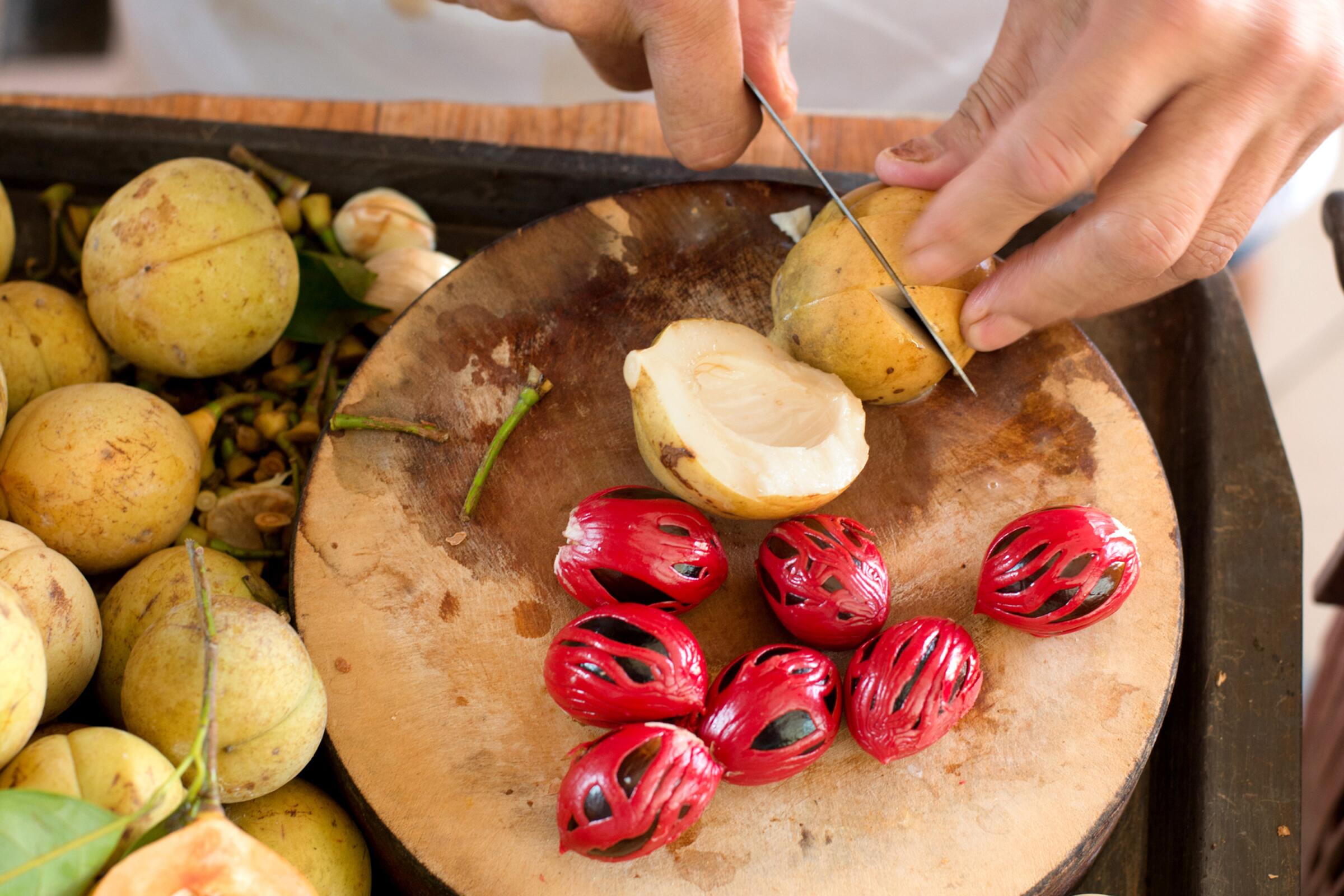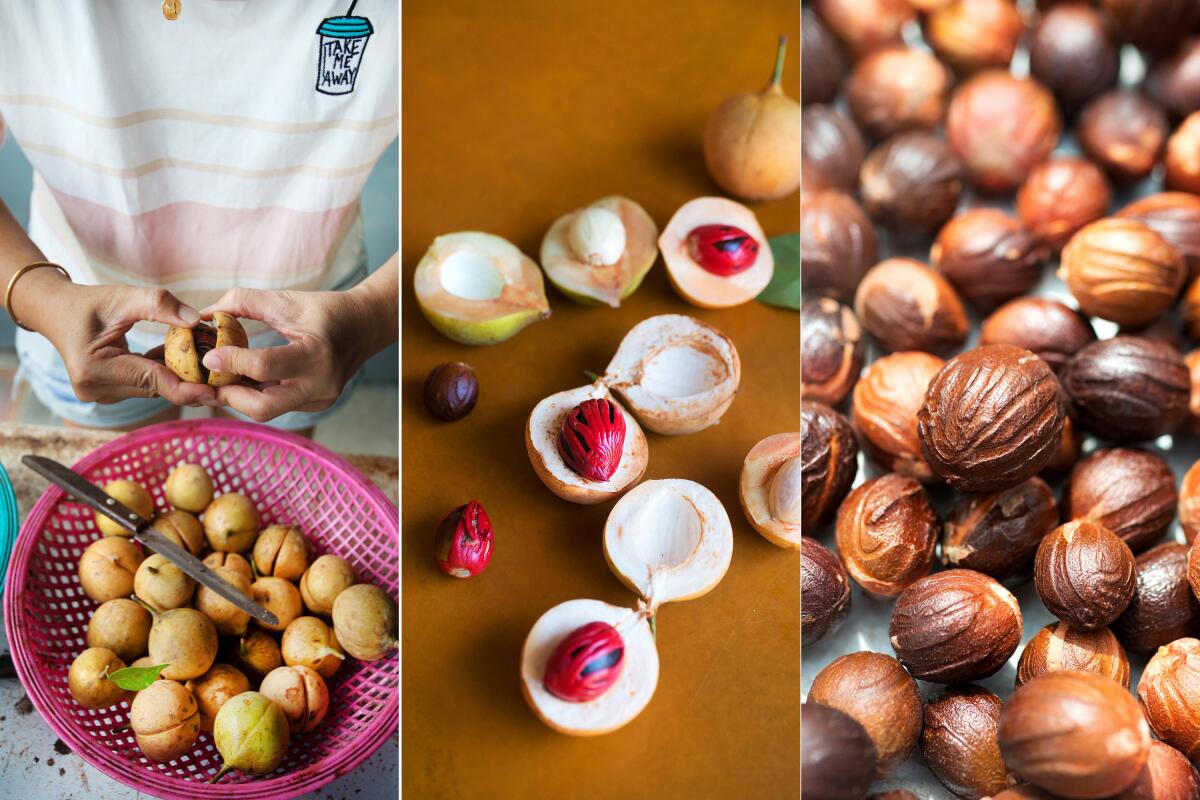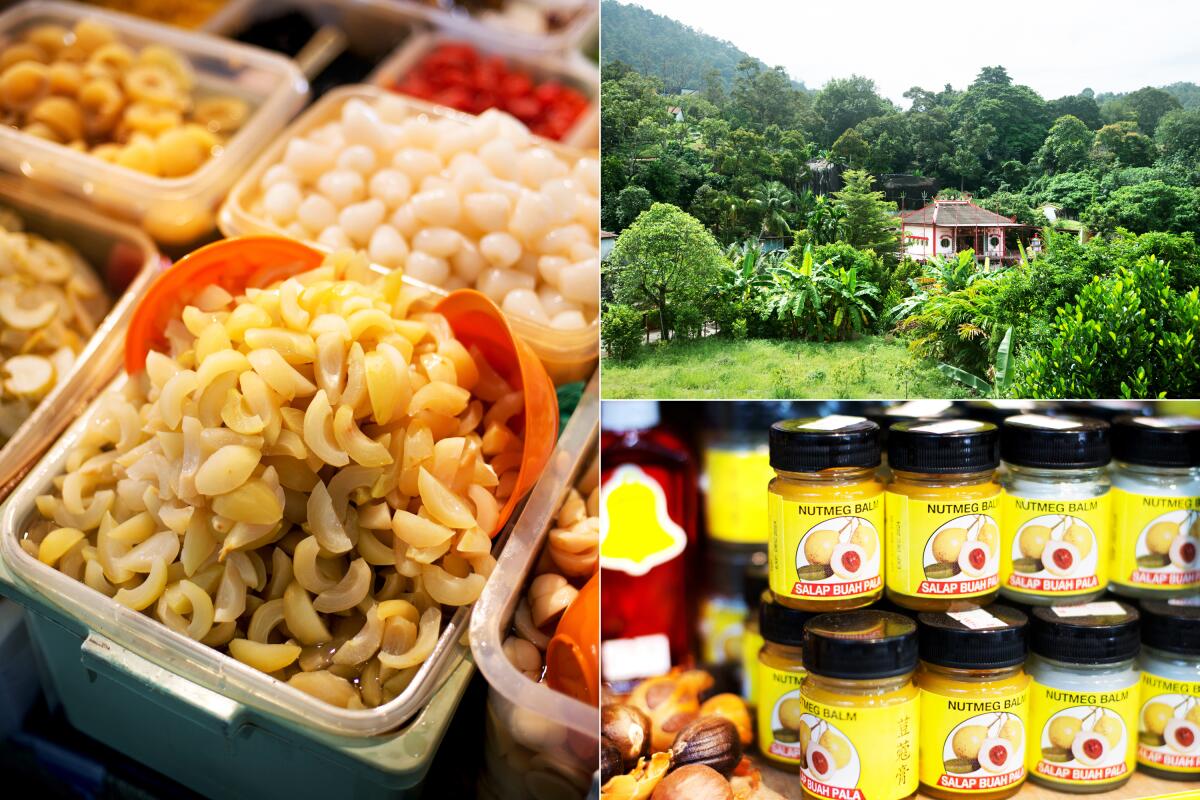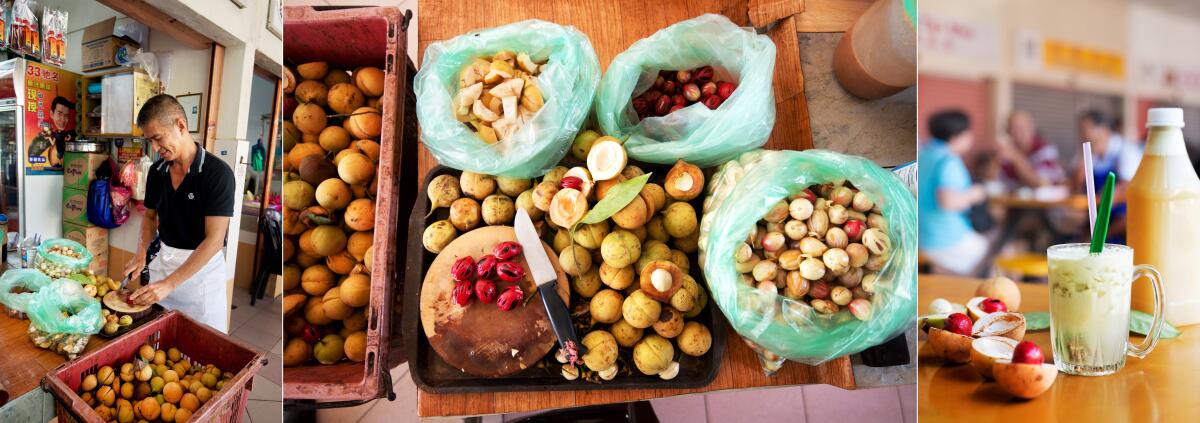Newsletter
Eat your way across L.A.
Get our weekly Tasting Notes newsletter for reviews, news and more.
You may occasionally receive promotional content from the Los Angeles Times.

PENANG, Malaysia — Come fall, even in places where temperatures still resemble summer, we in the United States start thinking of “warming” dishes: roasted meats, mashed potatoes, pumpkin pies, eggnog and, despite how you might feel about it, the most recent addition to the repertoire, the pumpkin spice latte.
Some of the warming attributes of these dishes come from their inherent heartiness and from our memories of eating them indoors, with family, during holidays. But those warm, fuzzy feels also stem from the associations we have with a specific repertoire of dried spices: namely clove, cinnamon and, perhaps most important, nutmeg.
I live in Southeast Asia, where turkey and stuffing are considered exotic dishes, but was reminded of these spices when I learned that Starbucks was bringing the pumpkin spice latte here for the first time.
In a way, it’s a homecoming. What we know as nutmeg is actually the seed of a fruit with origins in the sunny equatorial archipelago of Indonesia’s Maluku Islands — the fabled Spice Islands — which are also thought to be the source of clove, which along with cinnamon and ginger are what generally constitutes “pumpkin spice.”
But if you really want to see some serious nutmeg eaters, turn not to the Maluku Islands or even rural Connecticut at Thanksgiving, but rather Penang, Malaysia, where nutmeg is consumed in an astonishing variety of ways.

I’m in a mall on Penang with Jin Teong Ong, a native of the island and author of the cookbooks “Penang Heritage Food” and “Nonya Heritage Kitchen.” Over coffee, we’re talking nutmeg, about how for a period in the 19th century, his birthplace was an important producer and exporter of this once astronomically valuable commodity (these days, Indonesia is the world’s largest exporter of nutmeg). Yet it soon becomes clear to me that when talking about nutmeg on Penang, we are not talking about the seed, but rather the flesh of the fruit.
Jin Teong is Nonya, meaning he’s of mixed Chinese and Malay heritage, and he grew up eating pickled nutmeg and drinking nutmeg syrup, made from the coarse but fragrant flesh of the nutmeg fruit. He recalls that in the old days, ais kacang, the Malaysian dessert of shaved ice, often included candied nutmeg fruit. As a child, if he was feeling sore, he was rubbed with oil distilled from nutmeg fruit.
When I ask about dishes made with nutmeg seed, he seems briefly stumped. He mentions a Chinese soup that includes duck, pickled greens and whole nutmeg seeds, and tells me that during Chinese New Year, his family would make something called sugee cake, a baked good of possible Portuguese origins that includes nutmeg powder and pickled nutmeg fruit.
“I suppose in those days, they only exported the seed,” Jin Teong says, positing that this left the locals with an abundance of nutmeg fruit to deal with. “With the Chinese, we never throw anything away!”
The local fondness for nutmeg fruit is at the forefront at Chowrasta Market, the central market in George Town, Penang’s main city. There, vendors sit behind vats of sweet pickled fruit, the air heavy like a syrupy eggnog. I talk to Edmund Saw, owner of one such stall.
“Penang is the only place in Malaysia with nutmeg trees,” he tells me. “People from Malaysia, when they come here, they have to buy nutmeg products.”
He offers me a taste of pickled nutmeg fruit: It’s equal parts crunchy, sweet and sour, with a remote but discernible nutmeg fragrance. Another pickle, with the skin still attached, is astringent and slightly tart.

In addition to pickled nutmeg, Edmund also sells candied nutmeg, nutmeg licorice, nutmeg candies, balms and medicinal oils made from nutmeg fruit, and bottles of nutmeg syrup. It’s only in an almost hidden corner of his shop that I spy a few stray bottles of nutmeg powder.
“I’m not so interested in nutmeg; I’ve been around it since I was little,” he confides in me, laughing.
To see nutmeg at its source, I rent a car and drive to the village of Balik Pulau, literally, the Other Side of the Island. Divided from the port city of George Town by steep mountains, it is the agricultural heartland of Penang, where durians and cloves are grown on rugged hillside plots with little to differentiate them from the rocky jungle they spring from.
My first stop is 33 Coffee Shop, a cafe in a semi-open-air food court, where Kenny. K. K. Nah has made a name for himself selling fresh nutmeg juice.
For generations, people on Penang have simmered nutmeg fruit with rock sugar to make a syrup. Diluted with water, it has a sweet flavor and pink hue that evokes a lighter, fruitier Dr Pepper. Kenny claims that he was the first on Penang to juice the fresh fruit.
I enter Kenny’s tiny kitchen, and he tosses quartered nutmeg fruit into a jury-rigged electric juicer — nutmeg fruit is so woody it will mangle most normal juicers — and the air is filled with a rich, unfamiliar fragrance.
“When I juice nutmeg, sometimes it smells like root beer, and I know that that’s a high-quality fruit,” Kenny tells me, through an interpreter.

Raw nutmeg fruit is intensely astringent, sucking the moisture from your mouth, so Kenny and other vendors temper the juice with simple syrup and — a very Chinese touch — salted plum. The result has a pale green color, a hard-to-place fragrance and a slight but pleasant astringency — and is one of the most refreshing juices I’ve ever tasted. Kenny juices more than 600 pounds of nutmeg fruit a week (he sells the seeds for export); buses unload tourists at his stall who buy bottles of the stuff to take back to Kuala Lumpur or Singapore.
From 33 Coffee Shop, I drive through the palm-tree-bordered villages on the other side of Penang to Ghee Hup Nutmeg Factory. The area’s farms and plantations have become tourist destinations in themselves, and when I arrive, there are two buses of tourists getting a lesson in nutmeg from Kun Mim Chang, the third generation of his family to grow and process the stuff.
We were run out of the first bar.
Through a translator, he explains the difference between the male and female fruit (only the seeds of the female fruit will reproduce) and gives us a crash course in the differences between nutmeg flesh, seed and the stoplight-red membrane that surrounds it — which, dried, is the spice we know as mace.
He offers us a taste of nutmeg seed — the first time I’ve tried it since arriving on the island — and it’s both intensely fragrant and familiar, but compared with the vibrant flesh is almost a bit of a letdown. Emily Chang, Kun Mim’s daughter, tells me with palpable shock, “Tourists told me that European people use nutmeg for meat dishes, for pudding [dessert]. I didn’t know this!”
In Penang, I had tasted nutmeg in just about every conceivable form, I’d seen nutmeg trees and had witnessed where it was processed. But after returning home to Bangkok, I realized that there was one gaping hole in my research: I’d never tried a pumpkin spice latte.
It’s time for a good old pumpkin spice taste test video.
So I headed to my local Starbucks (the shops might be even more ubiquitous in central Bangkok than in many American cities) and exchanged the equivalent of $5 — a hefty sum by local standards — for a cup, and sipped. Was I hoping to be magically transported back to my hometown of Sandy, Ore., during Thanksgiving, making for a neat and tidy finale to this story?
Well, yes. But the drink was cloyingly sweet and rich — like a warm milkshake — masking the spices. It was gross, and all I wanted was a refreshing glass of fresh nutmeg juice.
Eat your way across L.A.
Get our weekly Tasting Notes newsletter for reviews, news and more.
You may occasionally receive promotional content from the Los Angeles Times.